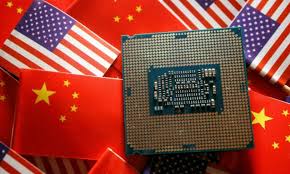
China’s commerce ministry has launched two formal trade investigations targeting U.S. semiconductor practices: an anti-discrimination inquiry into U.S. trade policy on chips and a parallel probe into suspected dumping of certain American analog chips. The timing — announced on the eve of a high-level U.S.–China trade delegation meeting in Madrid — signals a deliberate blend of legal manoeuvring, diplomatic signalling and industrial defence. Beijing’s actions are aimed at pushing back against Washington’s export controls and entity listings, creating bargaining leverage in talks, and protecting domestic supply chains at a moment when semiconductors have become central to geopolitical competition.
Timing and tactics: trade law used as a diplomatic tool
The two investigations were made public as a Chinese delegation prepared to enter talks with U.S. counterparts in Madrid. Anti-dumping and anti-discrimination probes are conventional trade remedies that provide a legal framework to examine whether imports are being unfairly priced or whether foreign policies amount to discriminatory treatment. By initiating these processes just before face-to-face negotiations, Beijing converted political grievances into procedural disputes — a move that makes specific trade irritants formally negotiable and hard to ignore during diplomatic exchanges.
Rather than an immediate imposition of retaliatory tariffs, launching investigations offers China a flexible instrument: it raises pressure on Washington while preserving space for dialogue. The inquiries require documentation, data exchanges and a formal timetable, creating sustained attention on the issues and giving Beijing institutional footholds to argue its case in parallel with political talks.
Historical backdrop: the semiconductor dimension of the U.S.–China trade rivalry
To understand the significance of the probes, they must be placed within the longer arc of U.S.–China economic frictions. Over the past several years, trade disputes between the two powers have moved beyond tariffs into the realm of technology controls. The United States has tightened export controls, restricted sales of advanced chipmaking equipment, and placed Chinese firms on entity lists that curb their access to key technologies. Those steps were framed by U.S. policymakers as necessary for national security; Beijing views them as economically coercive measures that inhibit China’s technological development.
In response, China has pursued industrial policies to boost domestic semiconductor capability and has occasionally deployed reciprocal trade measures. The escalation in controls and countermeasures reflects a broader strategic contest: semiconductors are now vital inputs for everything from consumer electronics to artificial intelligence and advanced military systems. The probes into U.S. chip practices are thus an extension of that contest, an attempt to rebalance leverage through trade law rather than open confrontation.
Strategic motives: signalling, leverage and domestic protection
Beijing’s decision to open these investigations is driven by several overlapping motives. First, signalling: formal probes send a clear message to U.S. policymakers, global markets and domestic audiences that China will defend its firms and industries through legal channels. That public posture matters both internationally and at home, where the government is sensitive to perceptions of weakness in the face of foreign restrictions.
Second, leverage: investigations create procedural momentum. They compel both sides to engage in evidence-based exchanges and can be used as bargaining chips in negotiations over export controls, entity listings and other bilateral irritants. A probe can slow market adjustments, impose reputational costs and extract concessions without the need for immediate, sweeping countermeasures.
Third, domestic industrial protection: the anti-dumping inquiry targets certain analog chips — widely used components in devices such as routers, sensors and audio equipment. These are segments where U.S. firms have significant market presence and where sudden price shifts or supply disruptions would directly affect Chinese downstream manufacturers. Examining alleged dumping gives Chinese authorities a tool to inspect commercial flows and, if injury is found, to impose remedies that shield local firms while Beijing presses for broader policy changes.
From a diplomatic standpoint, the probes function as choreography. They move complaints about export controls from heated rhetoric into a sequence of legal steps that can be negotiated with a degree of predictability. That proceduralisation can be helpful for negotiators who prefer to settle disputes through technical exchanges rather than public political warfare.
At the same time, the approach allows China to calibrate pressure. Investigations keep options open: if evidence supports measures, Beijing can escalate; if talks yield concessions, the probes can be used to secure or formalise commitments. For domestic audiences, the probes demonstrate action without the immediate economic disruption that blunt retaliatory tariffs can cause.
Economic and market consequences: volatility and structural shifts
In the short term, the probes are likely to introduce uncertainty for companies whose products fall within the scope of the inquiries. U.S. chipmakers could face procedural delays, compliance costs and the prospect of duties if dumping or discrimination is established. Chinese buyers and downstream manufacturers may react by adjusting orders, seeking alternative suppliers or accelerating local procurement plans.
Over the medium term, the investigations could catalyse structural responses across the semiconductor supply chain. Firms may further diversify sourcing to reduce exposure to geopolitical shocks; governments may step up public investment to onshore critical production; and suppliers in third countries could become strategic alternatives. The cumulative effect would be a further regionalisation of supply chains for sensitive components, with higher transaction costs and more pronounced industrial policy interventions.
What to watch in Madrid and beyond
The Madrid talks will reveal whether the probes become a protracted legal dispute or a tool for extracting concessions. Key indicators include whether China uses early findings to demand remedies, whether the United States responds with fresh trade-law or export-control measures, and whether negotiators agree on procedural steps to limit escalation. How both sides frame outcomes for domestic audiences will also matter: Washington faces pressure to defend perceived national-security prerogatives, while Beijing must show it can protect Chinese firms without inflicting self-harm.
Ultimately, the episode underscores a broader reality: semiconductors are now instruments of strategic competition. Trade law, export controls and industrial policy have converged into a policy arena where legal procedures are deliberately used to shape geopolitical outcomes. The probes are therefore not just regulatory actions but purposeful moves in a complex economic and strategic negotiation that will play out in courts, markets and diplomatic rooms alike.
(Source:www.business-standard.com)
Timing and tactics: trade law used as a diplomatic tool
The two investigations were made public as a Chinese delegation prepared to enter talks with U.S. counterparts in Madrid. Anti-dumping and anti-discrimination probes are conventional trade remedies that provide a legal framework to examine whether imports are being unfairly priced or whether foreign policies amount to discriminatory treatment. By initiating these processes just before face-to-face negotiations, Beijing converted political grievances into procedural disputes — a move that makes specific trade irritants formally negotiable and hard to ignore during diplomatic exchanges.
Rather than an immediate imposition of retaliatory tariffs, launching investigations offers China a flexible instrument: it raises pressure on Washington while preserving space for dialogue. The inquiries require documentation, data exchanges and a formal timetable, creating sustained attention on the issues and giving Beijing institutional footholds to argue its case in parallel with political talks.
Historical backdrop: the semiconductor dimension of the U.S.–China trade rivalry
To understand the significance of the probes, they must be placed within the longer arc of U.S.–China economic frictions. Over the past several years, trade disputes between the two powers have moved beyond tariffs into the realm of technology controls. The United States has tightened export controls, restricted sales of advanced chipmaking equipment, and placed Chinese firms on entity lists that curb their access to key technologies. Those steps were framed by U.S. policymakers as necessary for national security; Beijing views them as economically coercive measures that inhibit China’s technological development.
In response, China has pursued industrial policies to boost domestic semiconductor capability and has occasionally deployed reciprocal trade measures. The escalation in controls and countermeasures reflects a broader strategic contest: semiconductors are now vital inputs for everything from consumer electronics to artificial intelligence and advanced military systems. The probes into U.S. chip practices are thus an extension of that contest, an attempt to rebalance leverage through trade law rather than open confrontation.
Strategic motives: signalling, leverage and domestic protection
Beijing’s decision to open these investigations is driven by several overlapping motives. First, signalling: formal probes send a clear message to U.S. policymakers, global markets and domestic audiences that China will defend its firms and industries through legal channels. That public posture matters both internationally and at home, where the government is sensitive to perceptions of weakness in the face of foreign restrictions.
Second, leverage: investigations create procedural momentum. They compel both sides to engage in evidence-based exchanges and can be used as bargaining chips in negotiations over export controls, entity listings and other bilateral irritants. A probe can slow market adjustments, impose reputational costs and extract concessions without the need for immediate, sweeping countermeasures.
Third, domestic industrial protection: the anti-dumping inquiry targets certain analog chips — widely used components in devices such as routers, sensors and audio equipment. These are segments where U.S. firms have significant market presence and where sudden price shifts or supply disruptions would directly affect Chinese downstream manufacturers. Examining alleged dumping gives Chinese authorities a tool to inspect commercial flows and, if injury is found, to impose remedies that shield local firms while Beijing presses for broader policy changes.
From a diplomatic standpoint, the probes function as choreography. They move complaints about export controls from heated rhetoric into a sequence of legal steps that can be negotiated with a degree of predictability. That proceduralisation can be helpful for negotiators who prefer to settle disputes through technical exchanges rather than public political warfare.
At the same time, the approach allows China to calibrate pressure. Investigations keep options open: if evidence supports measures, Beijing can escalate; if talks yield concessions, the probes can be used to secure or formalise commitments. For domestic audiences, the probes demonstrate action without the immediate economic disruption that blunt retaliatory tariffs can cause.
Economic and market consequences: volatility and structural shifts
In the short term, the probes are likely to introduce uncertainty for companies whose products fall within the scope of the inquiries. U.S. chipmakers could face procedural delays, compliance costs and the prospect of duties if dumping or discrimination is established. Chinese buyers and downstream manufacturers may react by adjusting orders, seeking alternative suppliers or accelerating local procurement plans.
Over the medium term, the investigations could catalyse structural responses across the semiconductor supply chain. Firms may further diversify sourcing to reduce exposure to geopolitical shocks; governments may step up public investment to onshore critical production; and suppliers in third countries could become strategic alternatives. The cumulative effect would be a further regionalisation of supply chains for sensitive components, with higher transaction costs and more pronounced industrial policy interventions.
What to watch in Madrid and beyond
The Madrid talks will reveal whether the probes become a protracted legal dispute or a tool for extracting concessions. Key indicators include whether China uses early findings to demand remedies, whether the United States responds with fresh trade-law or export-control measures, and whether negotiators agree on procedural steps to limit escalation. How both sides frame outcomes for domestic audiences will also matter: Washington faces pressure to defend perceived national-security prerogatives, while Beijing must show it can protect Chinese firms without inflicting self-harm.
Ultimately, the episode underscores a broader reality: semiconductors are now instruments of strategic competition. Trade law, export controls and industrial policy have converged into a policy arena where legal procedures are deliberately used to shape geopolitical outcomes. The probes are therefore not just regulatory actions but purposeful moves in a complex economic and strategic negotiation that will play out in courts, markets and diplomatic rooms alike.
(Source:www.business-standard.com)





